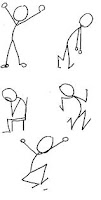Helping Kids on the Autism Spectrum to Develop Nonverbal Communication Skills
Question
My son doesn’t seem to understand others’ nonverbal messages, and he isn’t very good at sending clear nonverbal messages either. Are there ways to teach nonverbal communication?
Answer
 Children with High-Functioning Autism (HFA) and Asperger's appear to experience a lack of reciprocity in social interactions. This means the child does not fully understand nonverbal communication (e.g., gestures, facial expressions, etc.) and may continue a conversation even though the person he is talking to is confused about - or disinterested in - the subject matter.
Children with High-Functioning Autism (HFA) and Asperger's appear to experience a lack of reciprocity in social interactions. This means the child does not fully understand nonverbal communication (e.g., gestures, facial expressions, etc.) and may continue a conversation even though the person he is talking to is confused about - or disinterested in - the subject matter.In addition, the child may not use nonverbal communication himself, and as a result, may appear expressionless in most conversations or interactions with others.
There are lots of ways you can help your son improve his nonverbal communication skills by playing simple games.
Here are some ideas to help him improve his understanding of nonverbal messages:
Here are some ideas to help him improve his understanding of nonverbal messages:
1. Find some old magazines and ask your son to cut out pictures of people. After you have a selection of pictures, ask him to identify what the people in each picture are feeling. You may also talk with your son about how he made those choices. A similar exercise may be done with pictures of faces.
2. Look through magazines and cut out pictures of people wearing different types of clothing. Discuss with your son where each of these people is probably going, and what type of activity they might do when they get there. Also discuss where each type of outfit might be inappropriate and how people would react if someone showed up wearing it.
3. Tell or “hum” a story without using words. Let changes in your voice convey excitement, fear, happiness, and so forth. Ask your son to describe what the story was about and discuss differences between your son’s interpretations and your intended meanings.
4. Watch television together and ask your son to observe the ways that actors use their eyes to convey meaning. Talk with your son about what differences in eye contact mean (e.g., long and intense eye contact usually signals that something important is being said; prolonged looking away while talking may indicate dishonesty or disinterest).
Here is how you can help your son improve his nonverbal “sending” abilities:
1. Ask your son to “make faces at you” (e.g., have him express happiness, anger, sadness, disgust, fear, and surprise by using facial expressions - but not body movements).
2. Ask your son to tell you a story without words, either by “humming” the story as described above or by acting out the story.
3. Try having your son repeat a phrase (e.g., “I didn’t say you could go outside”) so that the phrase has different meanings (e.g., place the emphasis on “I” so that the phrase means that someone else said it -- or place the emphasis on “you” so that the phrase means someone else was allowed to go outside).
Remember to praise your son when he correctly identifies or conveys emotions, and coach him when mistakes are made.
These are just a few of the ways you can work with children on the autism spectrum while also improving their nonverbal communication abilities. Let your imagination run wild! You’ll think of many others, and you and your son will have fun while developing an important life-skill.
==> Videos for Parents of Children and Teens with ASD
Resources for parents of children and teens on the autism spectrum:
==> How to Prevent Meltdowns and Tantrums in Children with Autism Spectrum Disorder
==> Parenting System that Reduces Defiant Behavior in Teens with Autism Spectrum Disorder
==> Launching Adult Children with Autism Spectrum Disorder: Guide for Parents Who Want to Promote Self-Reliance
==> Teaching Social-Skills and Emotion-Management to Children with Autism Spectrum Disorder
==> Parenting Children and Teens with High-Functioning Autism: Parents' Comprehensive Handbook
==> Unraveling the Mystery Behind High-Functioning Autism: Audio Book
==> Crucial Research-Based Parenting Strategies for Children and Teens with High-Functioning Autism
==> Parenting System that Reduces Defiant Behavior in Teens with Autism Spectrum Disorder
==> Launching Adult Children with Autism Spectrum Disorder: Guide for Parents Who Want to Promote Self-Reliance
==> Teaching Social-Skills and Emotion-Management to Children with Autism Spectrum Disorder
==> Parenting Children and Teens with High-Functioning Autism: Parents' Comprehensive Handbook
==> Unraveling the Mystery Behind High-Functioning Autism: Audio Book
==> Crucial Research-Based Parenting Strategies for Children and Teens with High-Functioning Autism
____________________



